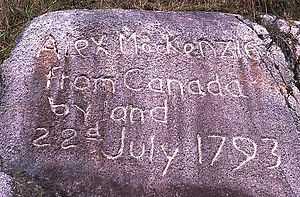North Bentinck Arm
Coordinates: 52°19′40″N 126°58′06″W / 52.3278°N 126.9683°W North Bentinck Arm is a short inlet about 17 km (10.6 mi) in length in the Central Coast region of British Columbia, Canada. It is a sidewater of Burke Channel and is linked via that waterway and Labouchere Channel to Dean Channel, which is one of the largest inlets of the BC Coast.
North Bentinck Arm is historically significant as the location where Hudson's Bay Company explorer Alexander MacKenzie reached the waters of the Pacific Ocean overland from Rupert's Land, on 20 July, 1793.[1] Wanting to see the open ocean he went by canoe with four Nuxalk natives the next day to Dean Channel, stopping at a site now part of Sir Alexander Mackenzie Provincial Park. A boulder on the shoreline there is marked with "Alexander MacKenzie, from Canada by land, 1793".[1] By only a few weeks MacKenzie missed meeting James Johnstone, one of Captain George Vancouver's men, who also visited North Bentinck Arm that year.

Name origin
North and South Bentinck Arms were named by George Vancouver, as "Bentinck Arms", in 1793, after the House of Portland; the Duke of Portland at the time was William Henry Cavendish Bentinck. [3]
Indigenous territory
The inlet is the territory of the Nuxalk Nation, whose main community adjoins the town of Bella Coola, which is at the head of the inlet. The Nuxalk are also known as the Bella Coola people.
See also
References
- ↑ 1.0 1.1 Hayes, Derek (2009). First Crossing: Alexander Mackenzie, His Expedition Across North America, and the Opening of the Continent. D&M Publishers Incorporated. pp. 211–224. ISBN 978-1-926706-59-7.
- ↑ Alex MacKenzie From Canada by Land 22d July 1793
- ↑ BC Names entry "North Bentinck Arm"